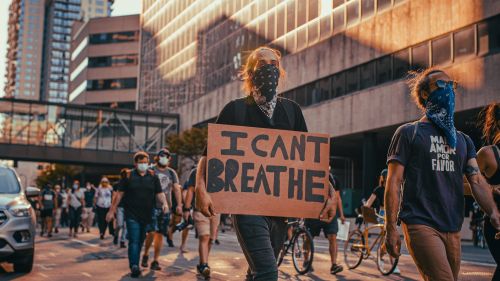In Protests, Cities Lead as Mayors Take a Back Seat

Samuel Kling examines the governability of urban areas in times of riots and pandemics.
To pundits already skeptical of city life, the extraordinary protests over the police killing of George Floyd revive old ideas of the ungovernability of urban places in America. As Ross Douthat writes in the New York Times, they expose the unsustainable fault lines of the “liberal city,” which lacks institutions with broad legitimacy to prevent mass unrest. Cities are being felled by “pandemics and pandemonium,” writes Joel Kotkin, spurred by “the suicidal embrace of the ‘riot ideology.’” As a result of the chaos, writes Forbes, “cities will see citizens flee, fearing continued riots” and governments unable to quell the disorder.
It would be a sharp reversal of fortune for US cities, which, until the pandemic, had been in the midst of a decades-long revival in economy, culture, and governance. Bolstered by burgeoning tax rolls and a sense of urban dynamism, city leaders proclaimed themselves the hope of American politics, problem solvers picking up the slack of a dysfunctional national government. “Mayors are now running the world,” former Chicago mayor Rahm Emanuel declared in a new book, hailing a kind of technocratic, pragmatic leadership focused on getting things done. Ex-South Bend mayor Pete Buttigieg built a presidential campaign off of his ability to move past partisan division “to get results and do it together.” And Michael Bloomberg, whose foundation funds urban policy initiatives, asserted that people must to look to cities, not Washington, to see “where big things are taking place.”
Indeed, mayors have been more involved in national and global politics, on issues from immigration to public health, joining together in organizations such as C40 to overcome federal obstinance on climate change. And as the federal government fumbled its coronavirus response, mayors became the face of leadership, marshalling unprecedented resources and conducting regular briefings as acts of civic education.
But the big things taking place now dull the technocratic mayoral luster. As protestors have made clear, “getting things done” often entailed upholding a racist system and brushing off demands for reform. Emanuel, Bloomberg, and Buttigieg each embraced aggressive policing practices activists denounced as racist, presided over police scandals, and left office unpopular among black constituents. Pragmatism often entailed giving the police the benefit of the doubt and presiding over widening racial inequities.
Rather than tout mayoral leadership, the protests have spotlighted mayoral deficiencies. New York Mayor Bill De Blasio, though elected on a police reform platform, oversaw a brutal NYPD crackdown that included officers ramming SUVs into demonstrators—and then praised officers for their “tremendous restraint.” In Minneapolis, Mayor Jacob Frey was powerless to stop MPD’s cruelty towards protestors or to stop demonstrators from burning down police stations and other buildings. In a poignant illustration of municipal impotence, Minneapolis did not even have the authority to arrest the offending officers, forcing leaders to wait through four days of angry protests before County Prosecutor Mike Freeman, representing a whiter, mainly suburban Hennepin County, announced charges. (A similar jurisdictional mismatch plagued the response to the Ferguson protests of 2015.)
Most urban municipalities have direct power over policing but have overseen abuses for decades. That the coronavirus kills blacks and Latinos at far higher rates, and that city governments have thus far been unable to bridge the gap, further contributes to the sense that the state, and cities specifically, works differently for people of color—a pattern with a long history in myriad urban policy areas.
But as the protests highlight the limits of top-down mayoral leadership, they stress the political and cultural power of cities from the bottom up. It took residents of Minneapolis—a prosperous, unequal city with a long history of police abuse and racial division, and also strong activist networks—to instigate demands for change. New York, Chicago, Los Angeles, and dozens of other dense cities fostered the movement, where cooped-up citizens flooded urban streets and public spaces. It spread from big, diverse cities to small, homogenous places such as Bangor, Maine, and Iowa City, and from the United States to London, Paris, and Sydney.
When it comes to addressing racial inequities, cities are playing a significant role in national and global politics—while mayors are taking a back seat. In Emanuel’s terms, mayors aren’t running the world; city people are, through organizations like Black Lives Matter, Black Visions Collective in Minneapolis, and hundreds of neighborhood organizations working to dismantle racial inequities. The protests speak to a movement for change reflective of the city itself.
If cities succeed in generating big reforms—as pledged in Minneapolis—it will be a credit to the power of urban democracy. And for mayors, the protests should serve as a reminder that getting things done can also mean dismantling the oppressive structures of city life.

